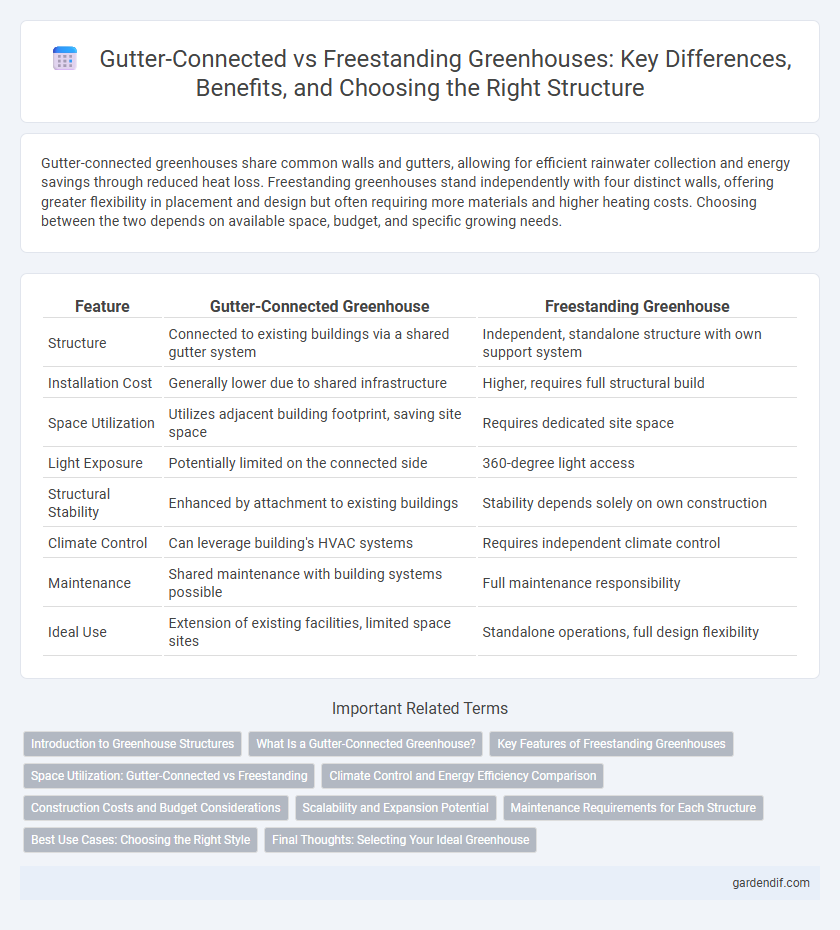
Gutter-Connected vs Freestanding Illustration
Gutter-connected greenhouses share common walls and gutters, allowing for efficient rainwater collection and energy savings through reduced heat loss. Freestanding greenhouses stand independently with four distinct walls, offering greater flexibility in placement and design but often requiring more materials and higher heating costs. Choosing between the two depends on available space, budget, and specific growing needs.
Table of Comparison
| Feature | Gutter-Connected Greenhouse | Freestanding Greenhouse |
|---|---|---|
| Structure | Connected to existing buildings via a shared gutter system | Independent, standalone structure with own support system |
| Installation Cost | Generally lower due to shared infrastructure | Higher, requires full structural build |
| Space Utilization | Utilizes adjacent building footprint, saving site space | Requires dedicated site space |
| Light Exposure | Potentially limited on the connected side | 360-degree light access |
| Structural Stability | Enhanced by attachment to existing buildings | Stability depends solely on own construction |
| Climate Control | Can leverage building's HVAC systems | Requires independent climate control |
| Maintenance | Shared maintenance with building systems possible | Full maintenance responsibility |
| Ideal Use | Extension of existing facilities, limited space sites | Standalone operations, full design flexibility |
Introduction to Greenhouse Structures
Gutter-connected and freestanding greenhouses differ primarily in design and structural layout, impacting space efficiency and climate control. Gutter-connected greenhouses share sidewalls, creating larger continuous growing areas ideal for commercial production, while freestanding greenhouses are standalone units suited for smaller-scale or specialized gardening needs. Choosing between these structures depends on factors such as available land, budget, and intended crop type to maximize growth potential and resource management.
What Is a Gutter-Connected Greenhouse?
A gutter-connected greenhouse is a type of structure where multiple greenhouse units share common walls and drainage systems, allowing for efficient water management and space utilization. These interconnected units facilitate climate control by maintaining consistent temperature and humidity levels across the entire complex. Compared to freestanding greenhouses, gutter-connected models offer scalability and cost-effective expansion for commercial horticulture operations.
Key Features of Freestanding Greenhouses
Freestanding greenhouses offer superior structural stability with their standalone design, allowing for enhanced customization in size and shape compared to gutter-connected models. They provide maximum sunlight exposure on all sides, optimizing plant growth by minimizing shadowing from adjacent structures. These greenhouses also facilitate better air circulation and easier access for maintenance, making them ideal for a wide range of horticultural applications.
Space Utilization: Gutter-Connected vs Freestanding
Gutter-connected greenhouses maximize space by sharing sidewalls, allowing for seamless row expansions and efficient land use, ideal for commercial operations requiring large cultivation areas. Freestanding greenhouses offer greater flexibility in positioning and individual climate control but typically require more land between structures, resulting in lower overall space efficiency. Optimizing space utilization depends on specific agricultural goals, with gutter-connected systems excelling in dense, large-scale production environments.
Climate Control and Energy Efficiency Comparison
Gutter-connected greenhouses share common walls, enabling better climate control by minimizing heat loss and facilitating uniform temperature regulation across connected units. Freestanding greenhouses, isolated from other structures, require independent heating and cooling systems, often resulting in higher energy consumption. Energy efficiency is enhanced in gutter-connected designs due to reduced surface area exposure and improved thermal retention, making them ideal for commercial climate-sensitive crop production.
Construction Costs and Budget Considerations
Gutter-connected greenhouses typically have lower construction costs due to shared walls and a unified structure, reducing material and labor expenses compared to freestanding greenhouses. Freestanding greenhouses require independent foundations and framing, which increases the overall budget but allows for greater design flexibility and site placement. Budget considerations should weigh initial construction savings against long-term maintenance and potential expansion needs.
Scalability and Expansion Potential
Gutter-connected greenhouses offer seamless scalability by allowing multiple units to be linked side-by-side, facilitating efficient expansion and consistent climate control across the entire structure. Freestanding greenhouses provide greater flexibility for independent placement and customized layouts but may require additional infrastructure when expanding. Choosing gutter-connected systems is ideal for growers prioritizing large-scale, continuous growth environments with straightforward expansion potential.
Maintenance Requirements for Each Structure
Gutter-connected greenhouses share walls and gutters, which requires regular inspection and cleaning of connecting gutters to prevent debris buildup and ensure proper water drainage. Freestanding greenhouses have independent drainage systems, reducing the complexity of maintenance but necessitating individual attention to each roof and gutter area. Maintenance for gutter-connected structures often involves coordinated efforts to address potential leaks or blockages in shared systems, while freestanding units benefit from easier access and isolated repairs.
Best Use Cases: Choosing the Right Style
Gutter-connected greenhouses are ideal for commercial growers or homeowners requiring large, expandable structures that maximize space and share walls, allowing for efficient irrigation and climate control integration. Freestanding greenhouses suit hobbyists or small-scale growers needing standalone flexibility, easy access on all sides, and a design adaptable to varied garden layouts. Selecting the right style depends on space availability, intended use, and budget, with gutter-connected offering scalability and resource sharing, while freestanding provides versatility and independence.
Final Thoughts: Selecting Your Ideal Greenhouse
Choosing between gutter-connected and freestanding greenhouses depends on space availability, budget, and intended use. Gutter-connected greenhouses offer cost savings and efficient space utilization by sharing walls, while freestanding greenhouses provide greater flexibility in design and location. Prioritizing energy efficiency, maintenance, and future expansion helps determine the ideal greenhouse setup for specific gardening needs.
Gutter-Connected vs Freestanding Infographic

 gardendif.com
gardendif.com